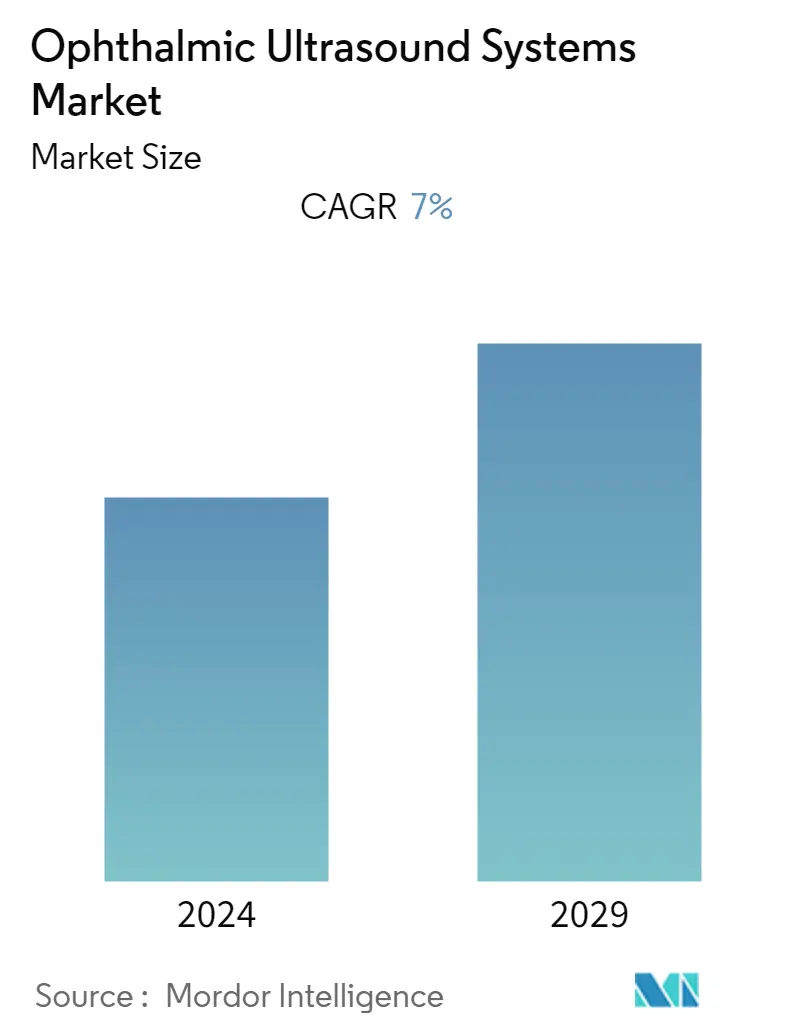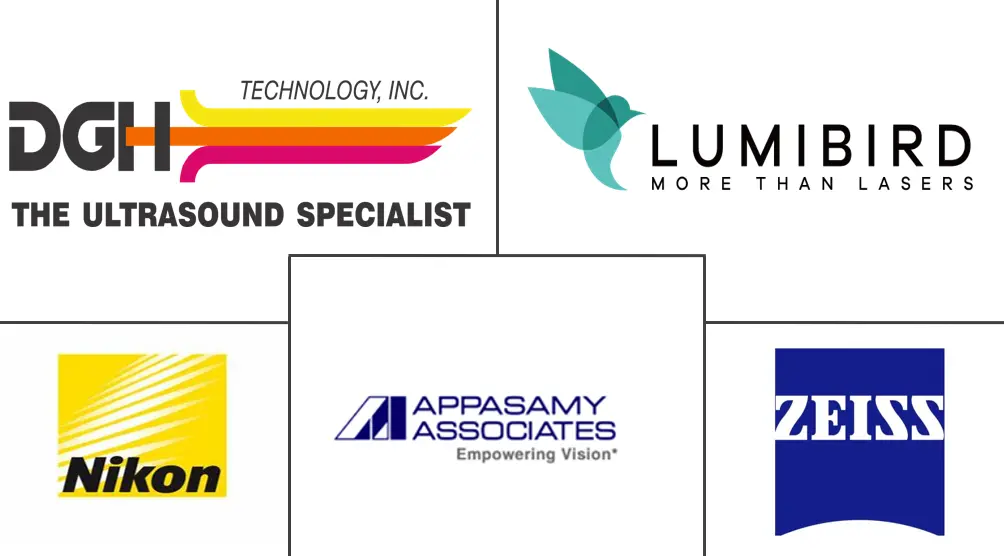
| Study Period | 2021 - 2029 |
| Base Year For Estimation | 2023 |
| Forecast Data Period | 2024 - 2029 |
| Historical Data Period | 2021 - 2022 |
| CAGR | 7.00 % |
| Fastest Growing Market | Asia Pacific |
| Largest Market | North America |
Major Players
*Disclaimer: Major Players sorted in no particular order |
Ophthalmic Ultrasound Systems Market Analysis
The ophthalmic Ultrasound Systems Market is poised to grow at a CAGR of 7% during the forecast period.
The pandemic had an effect on the market and various research studies provide insight into that. For instance, according to a research study published by Parul C Gupta et. al., in the December 2021 edition of the Indian Journal of Ophthalmology, the studied clinic was expected to perform 7,500 cataract procedures, but due to the pandemic, they were able to perform only 2,500 procedures. This data suggests a significant decrease in cataract procedures during the COVID-19 pandemic. However, with the increase in screen time owing to long working hours, ocular problems are one of the most reported problems worldwide and this may lead to an increase in the prevalence of optical disorders and boost the growth of the studied market during the studied period. For instance, as per a research study published in November 2021 by Jason M. Nagata et al., the average screen time of adolescents in the United States increased to 7.7 hours per day from 3.8 hours per day in pre-pandemic time and as per the same source, increase in screen time has a negative effect on the physical and mental state of the adolescent. Hence, the long-term impact of COVID-19 is expected to have a positive impact on the studied market.
The increasing burden of optical disorders such as myopia (nearsightedness), hyperopia (far-sightedness), astigmatism (distorted vision), and presbyopia, among others around the world are expected to be the major driving factor for the growth of the ophthalmic ultrasound systems market during the forecast period of the study. For instance, according to the October 2021 update of the World Health Organization (WHO), approximately 2.2 billion people around the world have near or distance vision impairment and about 1 billion of these cases of vision impairment could be prevented or are yet to be addressed. Further, as per WHO, unaddressed presbyopia is estimated to affect about 826 million people around the world. Also, as per the above-mentioned source, uncorrected refractive errors, cataracts, age-related macular degeneration, and glaucoma among others, are the major cause of vision impairment and blindness globally, and vision loss can affect people of any age but the majority is over the age of 50 years. Hence, the statements mentioned above indicate that there is a growing burden of eye diseases across the globe which is a fuelling factor for the growth of the market studied as ophthalmic ultrasound devices are used in the diagnosis of such eye diseases.
However, the increasing advancement and adoption of other diagnostic tools and rigorous government regulations are expected to hinder market growth.
Ophthalmic Ultrasound Systems Industry Segmentation
Per the report's scope, ocular ultrasound, also known as ocular echography, "echo," or a B-scan, is a quick, non-invasive test routinely used in clinical practice to assess the structural integrity and pathology of the eye. The Ophthalmic Ultrasound Systems Market is segmented by product (A- Scan, B- Scan, Combined Scan, Pachymeter, and Ultrasound Bio-microscopy (UBM)), modality (Portable and Standalone), end user (Hospitals, Ophthalmology, Clinics, and Others) and Geography (North America, Europe, Asia-Pacific, Middle East, and Africa, and South America). The market report also covers the estimated market sizes and trends for 17 different countries across major regions, globally. The report offers the value (USD million) for the above segments.
| A- Scan |
| B- Scan |
| Combined Scan |
| Pachymeter |
| Ultrasound Bio-microscopy (UBM) |
| Portable |
| Standalone |
| Hospitals |
| Ophthalmology Clinics |
| Other End-Users |
| North America | United States |
| Canada | |
| Mexico | |
| Europe | Germany |
| United Kingdom | |
| France | |
| Italy | |
| Spain | |
| Rest of Europe | |
| Asia-Pacific | China |
| Japan | |
| India | |
| Australia | |
| South Korea | |
| Rest of Asia-Pacific | |
| Middle-East and Africa | GCC |
| South Africa | |
| Rest of Middle-East and Africa | |
| South America | Brazil |
| Argentina | |
| Rest of South America |
Ophthalmic Ultrasound Systems Market Size Summary
The ophthalmic ultrasound systems market is experiencing a positive growth trajectory, driven by the increasing prevalence of optical disorders and the long-term impacts of the COVID-19 pandemic. The rise in screen time has contributed to a surge in ocular problems, which in turn is expected to boost the demand for ophthalmic ultrasound systems. The market is further propelled by the growing burden of eye diseases such as myopia, hyperopia, astigmatism, and presbyopia, as well as conditions like diabetic retinopathy, which necessitate advanced diagnostic tools. The aging population and the high incidence of vision impairment globally are significant factors fueling market expansion, as these systems are crucial for diagnosing and managing eye diseases. Despite the challenges posed by the adoption of alternative diagnostic tools and stringent regulatory frameworks, the market is poised for steady growth.
The market landscape is moderately fragmented, with key players like Appasamy Associates, DGH Technology Inc., and Nikon Corporation leading the charge. These companies are leveraging their research capabilities and distribution networks to maintain a competitive edge. Strategic acquisitions, such as Halma's purchase of IZI Medical Products and Alcon's acquisition of Ivantis, highlight the industry's focus on expanding product offerings and enhancing market presence. Initiatives like Lumibird Medical's expansion in India underscore the global growth potential of ophthalmic ultrasound systems. The North American region, characterized by high disposable incomes and a significant geriatric population, is witnessing increased demand for these systems, driven by the rising prevalence of eye diseases and the need for early diagnosis.
Ophthalmic Ultrasound Systems Market Size - Table of Contents
1. MARKET DYNAMICS
- 1.1 Market Overview
-
1.2 Market Drivers
- 1.2.1 Increasing Prevalence of Eye Diseases
- 1.2.2 Advent of Novel Ophthalmic Technologies
- 1.2.3 Rise in Public Health Awareness Programs by Government
-
1.3 Market Restraints
- 1.3.1 Increasing Advancement and Adoption of Other Diagnostic Tools
- 1.3.2 Rigorous Government Regulations
-
1.4 Porter's Five Forces Analysis
- 1.4.1 Bargaining Power of Suppliers
- 1.4.2 Bargaining Power of Buyers/Consumers
- 1.4.3 Threat of New Entrants
- 1.4.4 Threat of Substitute Products
- 1.4.5 Intensity of Competitive Rivalry
2. MARKET SEGMENTATION (Market Size by Value - USD million)
-
2.1 By Product
- 2.1.1 A- Scan
- 2.1.2 B- Scan
- 2.1.3 Combined Scan
- 2.1.4 Pachymeter
- 2.1.5 Ultrasound Bio-microscopy (UBM)
-
2.2 By Modality
- 2.2.1 Portable
- 2.2.2 Standalone
-
2.3 By End-User
- 2.3.1 Hospitals
- 2.3.2 Ophthalmology Clinics
- 2.3.3 Other End-Users
-
2.4 Geography
- 2.4.1 North America
- 2.4.1.1 United States
- 2.4.1.2 Canada
- 2.4.1.3 Mexico
- 2.4.2 Europe
- 2.4.2.1 Germany
- 2.4.2.2 United Kingdom
- 2.4.2.3 France
- 2.4.2.4 Italy
- 2.4.2.5 Spain
- 2.4.2.6 Rest of Europe
- 2.4.3 Asia-Pacific
- 2.4.3.1 China
- 2.4.3.2 Japan
- 2.4.3.3 India
- 2.4.3.4 Australia
- 2.4.3.5 South Korea
- 2.4.3.6 Rest of Asia-Pacific
- 2.4.4 Middle-East and Africa
- 2.4.4.1 GCC
- 2.4.4.2 South Africa
- 2.4.4.3 Rest of Middle-East and Africa
- 2.4.5 South America
- 2.4.5.1 Brazil
- 2.4.5.2 Argentina
- 2.4.5.3 Rest of South America
Ophthalmic Ultrasound Systems Market Research FAQs
What is the current Ophthalmic Ultrasound Systems Market size?
The Ophthalmic Ultrasound Systems Market is projected to register a CAGR of 7% during the forecast period (2025-2030)
Who are the key players in Ophthalmic Ultrasound Systems Market?
Appasamy Associates, DGH Technology Inc., Nikon Corporation (Optos Plc), Lumibird Medical (Quantel Medical) and Carl Zeiss Meditec AG are the major companies operating in the Ophthalmic Ultrasound Systems Market.


